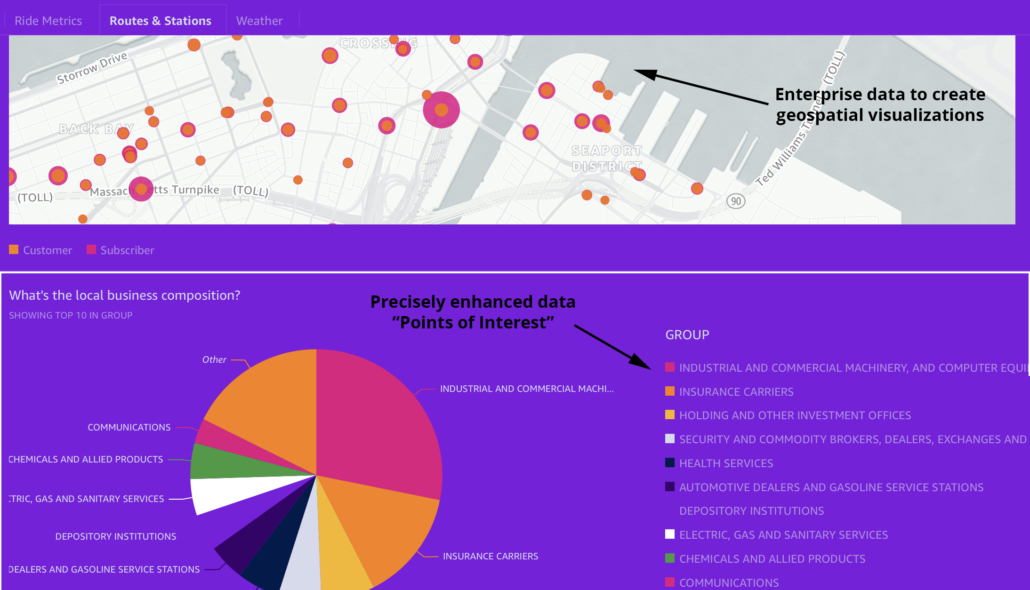Ironside, an Enterprise Data and Analytics firm, was featured in a Wall Street Journal article highlighting AI consultants that enable their clients to be self-sufficient with AI and not have to rely on their consulting counterparts to manage the model. A key part of Ironside’s strategy is having a broad portfolio of technology partners to see how they fit together to provide more value to our mutual customers. Two partners that fit together well are Precisely, an industry-leading Data Provider, and AWS, an Industry cloud leader. Precisely and AWS are technology partners — Precisely Data is offered through the AWS Marketplace and AWS Data Exchange. Ironside saw an additional opportunity for them to work together and Precisely was very interested to move forward.
Through Ironside’s combined expertise, in both Amazon QuickSight and Precisely’s expertly curated location data, they designed an enhanced business user experience for Amazon QuickSight customers. In this solution, Ironside leveraged Amazon QuickSight’s ability to ingest multiple data sources (like Precisely Points of Interest data stored in S3/Redshift/Snowflake) in addition to customer data repositories to create enriched Insights.

Exhibit A: Precisely Points of Interest Data providing Context to Amazon QuickSight Bike Sharing Ridership Dashboard
Ironside’s Practice Lead for Business Intelligence, Scott Misage, shared, “As the diversity and volume of data increase, organizations need to find ways to harness this data explosion and find pathways to bringing additional insights and intelligence to visualizations and dashboards. By leveraging the capabilities of these two complementary partners, it’s easier than ever for organizations to accelerate time to value with analytics.”
For Precisely’s Sales and Consulting teams, their Amazon QuickSight environment, created by Ironside, will provide them a User Experience to demonstrate how their data can enhance customers’ AWS data platform strategy. Matt Reaves, Vice President, Channel Sales at Precisely shared, “Ironside’s vision and expertise in execution has given our customers and sales teams great tools to showcase how Precisely Data can increase the value of their adoption of AWS. Ironside’s work with the QuickSight platform helps to demonstrate context for our multiple datasets.”
Precisely’s Amazon QuickSight environment is supported by Ironside’s Managed Service team with additional expertise from their Business Intelligence Practice. As new features in Amazon QuickSight are made available, Ironside works to incorporate them into the environment and assists the Precisely teams with understanding how these releases impact a customer’s use of Precisely Data for enriched Insights.
ABOUT IRONSIDE
Ironside helps companies translate business goals and challenges into technology solutions that enable insightful analysis, data-driven decision making and continued success. We help you structure, integrate and augment your data, while transforming your analytic environment and improving governance.
ABOUT PRECISELY
Precisely is a new company with a remarkable heritage. We were formed when Syncsort and Pitney Bowes Software & Data combined, bringing together decades of experience and expertise in handling, processing and transforming data. Precisely data integration, data quality, location intelligence, and data enrichment products power better business decisions to create better outcomes.
ABOUT AWS
Amazon Web Services has been the world’s most comprehensive and broadly adopted cloud platform for 14 years. AWS offers over 175 fully featured services for compute, storage, databases, networking, analytics, robotics, machine learning and artificial intelligence (AI), Internet of Things (IoT), mobile, security, hybrid, virtual and augmented reality (VR and AR), media, and application development, deployment, and management from 77 Availability Zones (AZs) within 24 geographic regions, with announced plans for nine more Availability Zones and three more AWS Regions in Indonesia, Japan, and Spain. Millions of customers—including the fastest-growing startups, largest enterprises, and leading government agencies—trust AWS to power their infrastructure, become more agile, and lower costs.




